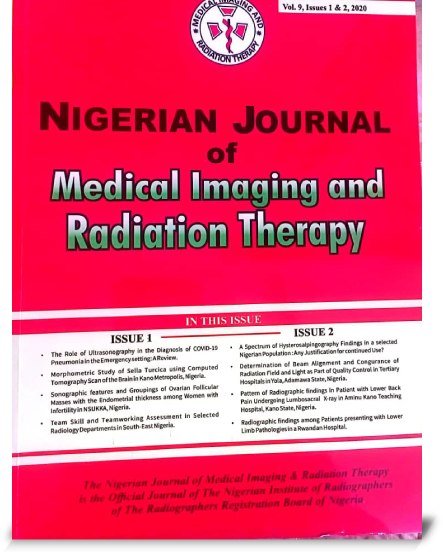INVESTIGATION OF THE CONSISTENCY OF EXPOSURE INDEX VALUES OF DIGITAL RADIOGRAPHY SYSTEMS IN NORTH-CENTRAL NIGERIA
Malachy C. Ejimofor1, Ibrahim Umaru2, Samson Y. Dauda2, Idris M. Mustapha2
Abstract
Background: The introduction of digital radiography has revolutionized radiography practice. The manufacturers of digital radiography have incorporated a numerical parameter called exposure index (EI) which is a direct estimate of entrance surface dose (ESD) on the imaging plate to allow for control of exposure factors and to mitigate against overexposure. However, the consistency of the exposure index values is uncertain.
Aim: The aim of this study was to investigate the consistency of exposure index values of digital radiography systems in repeated exposures under similar clinical conditions.
Materials and Methods: In this experimental study, five (5) computed radiography (CR) and seven (7) direct digital radiography (DDR) units which met the inclusion criteria were used to investigate the consistency of EI values. The X- ray tube voltage output and entrance surface dose were determined directly with multipurpose digital dosimeter, Cobia Smart R/F, while polymethylmethacrylate (PMMA) glass was used as phantom. The reproducibility of voltage output and entrance surface dose were initially established before data collection for consistency of EI values. For the consistency tests, 1cm thick glass was placed on the X-ray table and exposure parameters for hand was set. Six (6) exposures were taken, the EI, X-ray tube voltage output and ESD recorded each time.
Results: The results showed exposure index value status in computed radiography (CR) units as 43%, 28% and 29% for consistent, inconsistent and undefined respectively. For direct digital radiography (DDR) units, the exposure index status was 45%, 33% and 22% for consistent, inconsistent and undefined respectively. Fujifilm CR-IR 392 produced the least variation of EI values (1.91%), while Fujifilm FCR Capsula XL II produced the highest variation of EI values (58.47%). Vacutec VacuDAP compact DDR produced the least variation of EI values (0.66%), while EASYDR CXD1401G compact produced the highest variation of EI values (39.67%).
Conclusion: There was no overall difference in the performances of computed radiography (CR) and direct digital radiography (DDR) systems in this study and the inconsistencies in the EI values of CR and DDR systems remained significant. The pattern of variations of EI values between CR and DDR were similar in the study. The reasons for the observed inconsistencies of EI values could be due several factors such as variations in system calibration, the condition of the imaging equipment, and operator issues. Others are inadequate equipment maintenance and lack of standardized protocols.



